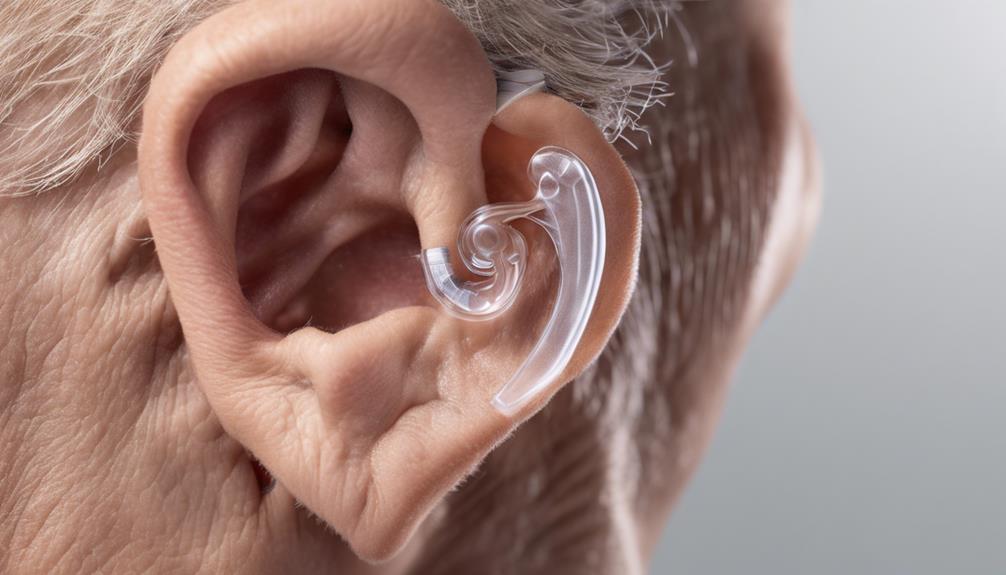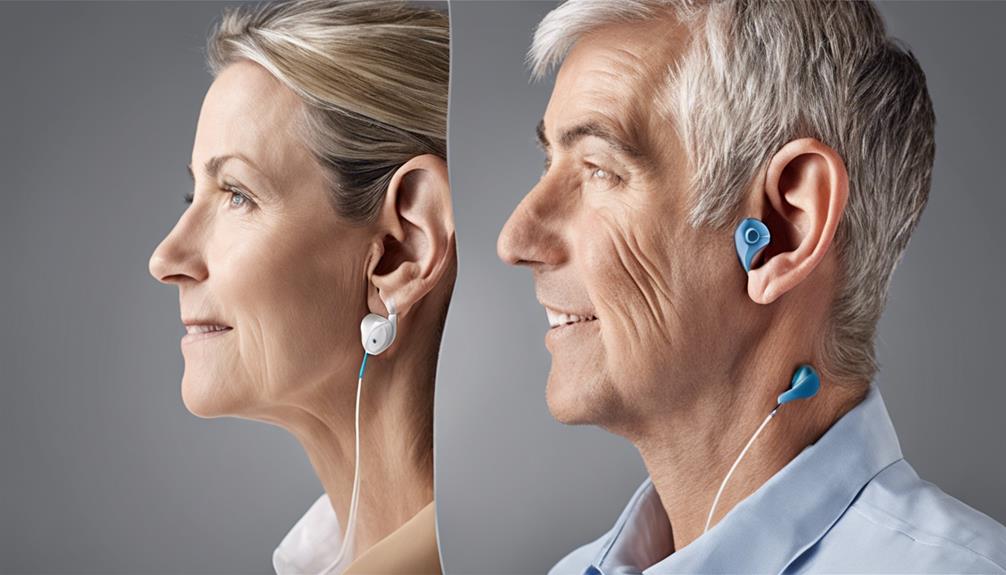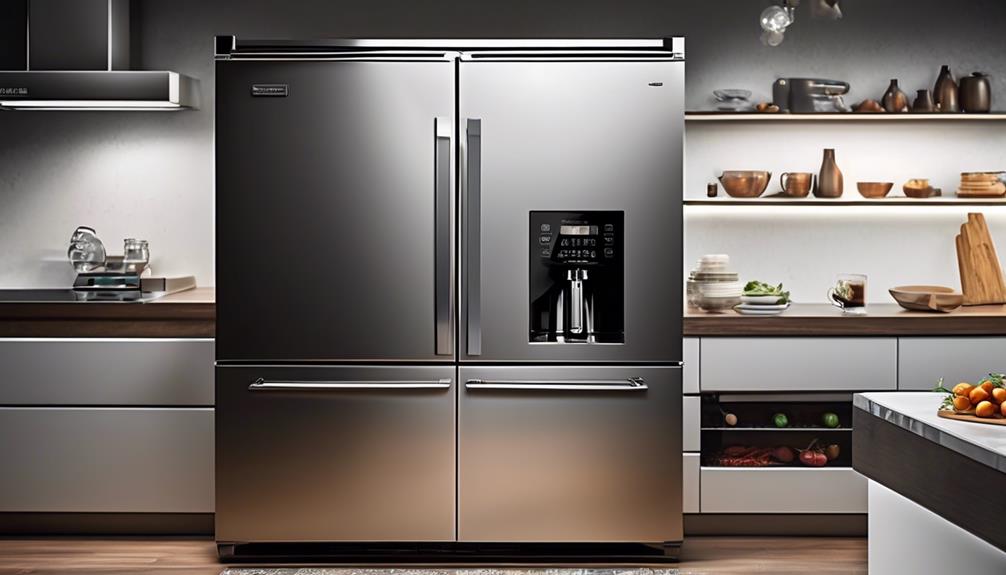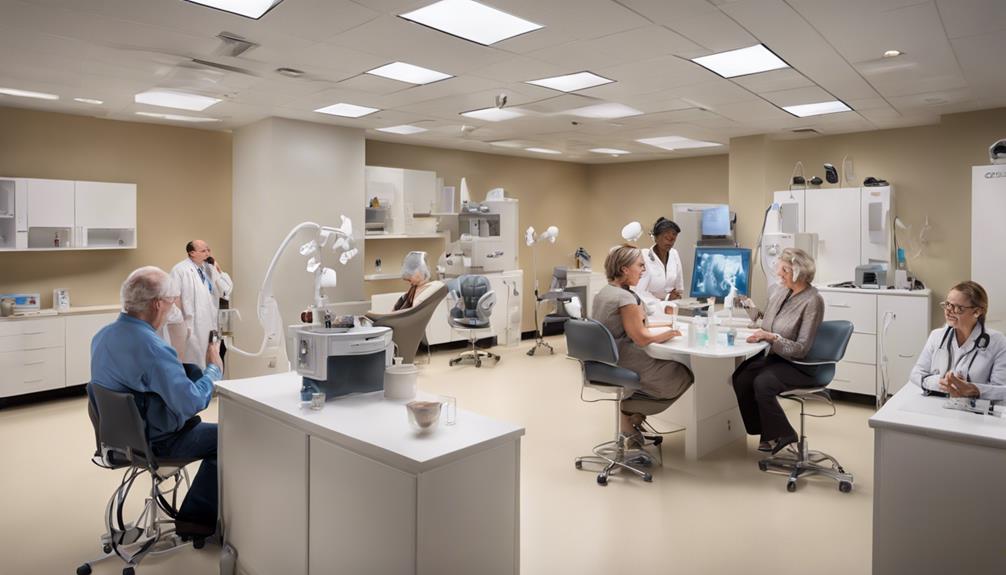In terms of Open Fit Hearing Aids, the concept of ‘less is more’ is crucial. The streamlined design and capacity to provide a natural sound to the user are significant factors in their appeal.
But, have you ever wondered how these tiny devices manage to provide such clarity without blocking the ear canal?
Let's explore the intricacies of Open Fit Hearing Aids and uncover the benefits that have made them a go-to choice for those seeking discreet and comfortable hearing solutions.
Key Takeaways
- Prevents wax and moisture buildup
- Suited for mild to moderate hearing loss
- Minimizes background noise effectively
- Offers quick supply and fitting process
Benefits of Open Fit Hearing Aids
Open fit hearing aids offer distinct advantages that set them apart from traditional hearing aid options. One significant benefit is the prevention of wax and moisture buildup in the ear canal. This advantage not only contributes to better hearing but also reduces the risk of infections. Additionally, the quick supply and fitting process of open fit hearing aids make them convenient for individuals with hearing impairments.
Another key benefit is the reduction of background noise. Open fit hearing aids are designed to amplify external sounds while minimizing internal sounds, leading to a clearer listening experience. Furthermore, users often experience less feedback with open fit hearing aids compared to other types, enhancing comfort and overall satisfaction. The availability of inexpensive tube replacements for open fit hearing aids simplifies maintenance, making it easier for individuals to keep their devices in optimal condition.
How Open Fit Hearing Aids Work

Building on the advantages highlighted in the previous section, the functionality of open fit hearing aids revolves around their unique design and technological capabilities.
Open fit hearing aids utilize a slim tube design that sits comfortably in the ear canal, allowing for natural sound perception while avoiding the feeling of blockage. These aids work by capturing sounds through a microphone, then amplifying and transmitting them through a speaker, resulting in improved clarity for the wearer.
Specifically suited for individuals with mild to moderate hearing loss, open fit hearing aids are particularly beneficial for those with earwax buildup issues due to their design that prevents occlusion. To determine the suitability of open fit hearing aids based on individual needs and the level of hearing loss, consultation with audiologists is essential.
Comparison With Closed Fit Aids
When comparing open fit hearing aids to closed fit aids, the suitability for differing levels of hearing loss becomes evident through their unique design features and functionality.
Closed fit aids are more appropriate for individuals with severe hearing loss or profound hearing impairment as they reduce external sounds and provide increased volume through closed domes. In contrast, open fit aids are typically better suited for lower to medium levels of hearing loss due to their design that allows for natural sound perception.
Vents in open fit aids play a crucial role in preventing the sensation of blocked ears and maintaining comfort. While closed fit aids offer more amplification and isolation from external noises, open fit aids prioritize a more natural listening experience.
Individuals with varying degrees of hearing loss can benefit from the distinct advantages offered by open fit and closed fit aids, depending on their specific needs and preferences.
Considerations for Choosing Open Fit Aids

Considering the specific needs of individuals with mild to moderate high-frequency hearing loss, selecting open fit aids involves assessing factors like ear canal size, ear length, and the potential benefits for those with excessive earwax buildup.
When choosing Open Fit aids, a crucial step is consulting a hearing healthcare professional to ensure the suitability of these devices for the individual's hearing loss profile.
It's important to note that open fit aids may require more frequent battery changes compared to other types of hearing aids due to their design.
The slim tube and dome options available for Open Fit aids offer a customized fit, accommodating individual ear lengths and canal sizes. This customization enhances comfort and sound quality for the wearer.
Limitations of Open Fit Hearing Aids
Open fit hearing aids present limitations in their effectiveness for individuals with severe or profound hearing loss. When considering these devices, it's essential to be aware of the following factors:
- Dexterity Issues: People with dexterity challenges may struggle to manage open fit hearing aids due to their small size and intricate components.
- Battery Changes: Open fit hearing aids typically necessitate more frequent battery replacements than other types of hearing aids, which can be cumbersome for some users.
- Consultation: It's crucial to consult a hearing healthcare professional before opting for open fit hearing aids. They can assess specific hearing needs and determine if these devices are suitable for the individual.
- Suitability for Severe or Profound Hearing Loss: Individuals with severe or profound hearing loss may not derive significant benefits from open fit hearing aids, as these devices may not provide adequate amplification for their level of hearing impairment.
Considering these limitations is vital in making an informed decision about the most appropriate hearing aid solution for individual needs.
Frequently Asked Questions
What Are the Disadvantages of Open Fit Hearing Aids?
We've considered the disadvantages of open fit hearing aids.
It's important to note that these aids mightn't be the best choice for individuals with severe or profound hearing loss.
Those with dexterity issues may find managing the small size challenging, and frequent battery changes are often necessary.
Consulting a hearing healthcare professional is crucial to determine if open fit hearing aids suit specific hearing needs, as they're typically tailored for mild to moderate high-frequency hearing loss.
What Does Open Fit Mean in Hearing Aids?
When we talk about 'open fit' in hearing aids, we're describing a design that allows for a more natural sound experience by not completely blocking the ear canal. This setup permits better ventilation and sound perception, especially for mild to moderate high-frequency hearing loss.
It's a less obtrusive and more comfy option than some other hearing aids. However, it may not be suitable for severe hearing loss and could require more frequent battery changes.
What Is the Difference Between Open Fit and Closed Fit Hearing Aids?
When comparing open fit and closed fit hearing aids, the key differences lie in their design and functionality. Closed fit aids block external sounds and increase volume, suitable for severe hearing loss.
On the other hand, open fit aids have vents for natural sound perception and are more comfortable for lower to medium levels of hearing loss.
It's crucial to consult a hearing healthcare professional to determine the best option tailored to individual needs and preferences.
How Do You Look After Open Fit Hearing Aids?
When caring for open fit hearing aids, we must follow several key steps:
- Clean them regularly with the provided tool to prevent wax buildup.
- Store them in a dry place when not in use to prevent moisture damage.
- Replace the domes every 3-6 months for optimal performance.
- Avoid exposure to extreme temperatures and direct sunlight to prevent damage.
Regular check-ups with a hearing healthcare professional are essential to ensure proper functioning and adjustments. Our team emphasizes these maintenance steps for reliable device performance.
Conclusion
Overall, open fit hearing aids offer numerous benefits such as natural sound perception and comfort. They're a popular choice for mild to moderate hearing loss due to their slim tube design. However, they may not be suitable for severe hearing loss.
When considering open fit aids, it's important to consult with a hearing healthcare professional to determine the best option for your specific needs.
Are you ready to experience improved hearing with open fit technology?









